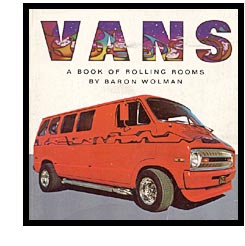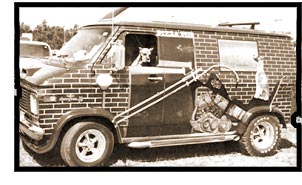![]()

by Baron Wolman
(text by John Burks)
(Doubleday & Co., Garden City, NY, 1976)
In my record collection I have what I call the “seen everything” category — albums like Drag Race Sound Effects or Music for Your Plants which I don’t actually listen to much, but like to keep around for the sole purpose of showing off to jaded jackasses who insist that there’s nothing they haven’t heard. A very similar effect can be had with Baron Wolman’s horizon-expanding book Vans: A Book of Rolling Rooms.
More at home on a coffee table than in the garage, this book is a classy, full-color photographic celebration of the custom van at its most stunningly extravagant. What’s that, you’ve never seen a van with Coors barrels for seats? Or a fireplace? Or full upholstered naugahyde with stained glass windows? How about the minimalist Japanese tea room, complete with samurai swords on the bamboo wall? It’s all here, amongst plenty of the more “traditional” fun fur and shag carpet that we’ve all come to expect. The artfully-composed photos follow a nice, subtle progression from amazing paint and body jobs to truly mind-altering interiors, focusing on all the little one-of-a-kind details that make for a truly custom vehicle. Every time I browse through this book—and that’s quite a bit—I spot something new, whether its the detail of a nude woman with butterfly wings, the mirrors on the ceiling of a blue velvet room, or the intriguing mural of a van convoy and flying saucers engaged in a heated laser battle.
As if the photos aren’t pleasure enough, there are also five pages of John Burks’ brilliant text, chronicling a brief history of vanning from its hot rod / surfer origins, and offering up some priceless firsthand accounts of a mid-seventies van event. There’s no shying away from vanning’s R-rated roots here:
“We’re gonna party! Paaarrrtttyyy!” someone bellows. “Rock and roll! Rock and roll!” is the reply. “We’re gonna booooo-gie! We’re gonna boooooooo-gie!” (sic)
A woman named B.J., better known to her club as “The Naked Lady”, comments, “I don’t smoke, right? I don’t drink, right? But I sure do take my clothes off, for just dumb reasons.” The list of van names alone is worthy of a time capsule. “Beaver Patrol...Passion Pit...Dick’s Inn...Mister Toad’s Wild Ride...Heavy Duty...Me No Need Motel...” There’s a rightful emphasis on the mindset involved, the sense of “Not having to do a single damn thing you don’t wanna”, an egalitarian party atmosphere “free of petty sectionalism”, the grass-roots artistry of “the true people’s funk.” Interestingly, in a paragraph about “the future” (i.e. after 1976), a vanner is sadly accurate in his prediction of vans becoming smaller and more compact—though not so visionary in his belief that “the off-road kick...will disappear”. The piece, like the whole book, serves up a delectable, seamless blend of heady anthropology and plain old obnoxious fun. In his most insightful, telling moment, Burks recognizes “the masterpieces of kitsch, wherein every detail is so banal and so out of sync...that they rivet your attention.” As he so eloquently sums it up, “It’s a lot like rock & roll.” Click here to check out photos from Rolling Rooms.
 The Do-it-yourself Custom Van Book
The Do-it-yourself Custom Van Book
by Franklynn Peterson
and Judi R. Kesselman
(Henry Regnery Co., Chicago., IL, 1977)
It was ten years ago that my friends and I discovered this book on the shelves of the Riverview High School library. My life has never been the same. I credit this book with singlehandedly rekindling my childhood obsession with all things customized and sending me gently on my way toward a life of vanaticism. Today, that very same copy holds an esteemed place on my bookshelf, and not a night goes by that I don’t take it down and look to it for spiritual, mental, or mechanical guidance.
All personal biases aside, this is by far the most authoritative van book I’ve yet to find. At the height of the mid-seventies van craze, Frank and Judi took to the road in swinging style, and left no wheel unturned. The result is a remarkably thorough and practical hands-on guide to creating your own “pad on wheels”, with heavy emphasis on personal style and a refreshing dose of the fun, free-wheelin’ populism that helped make vanning great.
The book is divided into clear, easily-referenced chapters, progressing from insightful (if sadly outdated) advice on buying a vehicle, through a myriad of very custom interior projects, and finally into the dazzling world of airbrushes and trim. Whether you’re installing a set of headphone jacks or building the complete, chain-suspended “Easy Rider” bed-n-dinette set, you’ll find the plans you’re looking for, with optimistic step-by-step instructions and plenty of diagrams. Best of all, each project is rated for time and difficulty using a unique system of weekends. A fancy bed, for example, rates “two or three weekends”, wood walls “a month of Sundays”, while a simple seat assembly takes “about one Saturday, assuming there’s no game on TV.” Photos appear throughout and, although limited to black-and-white, they go a long way, especially where the outrageous murals are concerned. There are some nice spreads of satisfied owners enjoying truly amazing vans, and a decent gallery of spare-tire-cover art (most of which, perhaps fittingly, hails from my home turf of Southeast Michigan.) There’s even an idealistic final chapter devoted to the imagined future of custom vans, with dazzling artistic visions of a world populated by enormous, stylized “supervans”. (A sad contrast, in retrospect, to the all-too-real horror of the minivan.)
What really makes this book stand out is its constant, playful invocation of a larger vanning philosophy—the custom van spirit, if you will. While packed full of technical specifics, it never loses sight of the underlying do-it-yourself ethic, or the fact that custom vans are just plain freaky. The very first chapter, “The Van and What to Do with it”, deals with the cultural significance of custom vans as icons of freedom, invoking the classically American images of on-the-road escapism and individuality gone wild. “Vans,” they write, “can be whatever you want them to be...Most people who’ve tried vans or are ready to try vans don’t care very much about why other people like vans.” While not much gets said directly about certain more worldy van pastimes—sex and drugs, for example—the book does reveal a sly, decidedly seventies obsession with privacy. For all their praise of family trips and eager sportsmen, Frank and Judi’s true sentiments shine through in descriptions like this one: “Insulated, carpeted, padded, softly lit, and loudly serenaded, they’re back in the womb, and there’s only a tiny porthole window or two poked into the carefully polished steel sides, offering their young occupants the privacy they feel they need from picky disapprovers in the straight world.” Indeed.
by Allan Girdler
(Tab Books, Blue Ridge Summit, PA, 1975)
I’m all for people working on their vans, however plain or crazy they want to be about it. The most mundane, insignificant do-it-yourself improvement is still better than a van left bare or (gasp!) subjected to the cookie-cutter sterilityof a factory conversion job. But reading through this stunted, dull-as-dirt book, I can’t help but suspect that either Mr. Girdler was just another nonfiction hack trying weakly to cash in on the craze-of-the-minute, or this guy owned one very boring fucking van.
You won’t find any daring, one-of-a-kind interior themes here, nor will you be astounded by the brash creative overexertion of any otherworldy murals. In fact, you won’t find much beyond a few lame, ho-hum interior projects (wow! a storage box!), a fleeting intoduction to painting techniques, and some uninspired ideas about tacking up carpet. To his credit, Girdler seems to know his machine, but never manages to progress beyond mere adequacy, and the book ends up reading like a Popular Mechanics article—all procedure, no style. People in need of only the most practical, nuts-and-bolts tips may find this stuff useful, but those looking for some truly quirky custom jobs will be quickly disappointed. “A-ha!” I can hear my critics saying, “But some of us might want to decorate our vans more conservatively!” Yeah, and you can paint your room a nice tasteful white, but that doesn’t mean I want to read a book about it.
What’s really offensive is Girdler’s gaping disregard for any larger, unifying van aesthetic. I don’t propose that every technical guide needs to go in depth into the heart and ideals of the van life (though it’s pretty great when they do). But in Girdler’s schoolbook style there’s more than a hint of condescension, an air of “don’t try this at home” pessimism that ultimately defeats the entire purpose of books like this and of customization at large. Amongst a culture that thrives on innovation, he insists on regimen. It’s an annoying and limited attitude, and one that pales in comparison to the more lighthearted do-it-yourself enthusiasm of classics like Peterson and Kesselman’s (see above).
Apparently I wasn’t the only person who found this book a little stale. The second edition contains some notable changes, overtly geared toward the, uh, more human element of mid-seventies young America. It features most of the same sleep-inducing text, but this time highlighted, at random points, by a series of educational photos detailing the myriad ways in which an anorexic, feather-haired woman in a bikini can enjoy her van. This and a cool chart of window shapes make the second edition worth looking at, but as far as real information, there isn’t anything here that isn’t presented better—and much more earnestly— somewhere else.
by Donald J. Davenport
(The Gemini School, Troy, MI, 1983)
With the apparently unceasing modern trend toward generic, uninspired auto detailing, the life of a custom airbrush artist seems an endangered one. Sure there’s the occasional tour bus in need of a horse scene, but the average vehicular Van Gogh is sadly lacking in rolling canvases, and many, in obvious despair, resign themselves instead to a life of crude t-shirts and spangled denim jackets. Like the scribes of pre-Guttenberg Europe, or the newspaper engravers toiling in the impending shadow of photography, the modern automotive airbrusher may very well become yet another arcane curiosity, another lowly footnote to the highbrow history of “respectable” art. We chuckle, but somewhere another muralist fades away like so much Arizona enamel, and with him goes the irreplacable, hands-on knowledge of what may soon very well be an extinct and forgotten craft.
Which is why a booklet like Donald J. Davenport’s Street Art is so important. Mr. Davenport was the founder and director of the Detroit area’s own Gemini School of Art and Design, the first freehand airbrush education program in the United States. The school has since vanished, at least under its original moniker (anyone with information to the contrary should please let me know), but thanks to this humble tome, Davenport’s legacy lives on.
While not strictly about vans—there are quite a few truly gaudy Corvettes and motorcyles as well—the majority of lessons in this book focus directly on the art of the airbrushed van mural. Davenport takes us methodically through the processes of selecting and maintaining the right equipment, preparing the surface and, finally, laying the picture on in all its pressurized glory. Along the way we pick up on a few other useful skills like glass engraving, lettering, pinstriping, and even gold leafwork. The stunted, textbook-style language doesn’t exactly jump off the page, but the instructions are, for the most part, clear and easy to follow. Thankfully, in the awkward moments when Donald’s words fail him, the photography more than compensates, with full color shots accompanying the instructions every paint-dusted step of the way.
“Painting a subject with an airbrush,” Davenport writes, “will allow you to express your imagination...” And what an imagination Don has. In the course of the book, his vanside expressions include: a deer-infested snowscape, the obligatory starry pegasus, a fuzzy white kitty, two St. Bernards smoking cigars and drinking beer from steins, and (my personal favorite) “ape like creatures in defiance of a strange forceful being emerging from a fog bank type landscape.” There are also a few pages which apty demonstrate the nasty effects a little bit of airbrush work can have on an otherwise appealing and valuable car. There’s one painting, too, which I’m still not quite able to describe. Colorful wood nymphs, perhaps? The hidden demons in Donald’s soul? Maybe the beautifully-rendered mushrooms on the cover had something to do with it.
Whatever your subject (or drug) of choice, this book will no doubt get you well on your way toward transforming a personal vision into a shimmering, van-sized reality. Less procedure-minded people may find its details a bit tedious, but for the aspiring airbrush artist, this book is a goldmine of lost knowledge and helpful tips. And I like to think that, maybe, just maybe, a relic like this could one day serve as the blueprint for a new renaissance in custom van art.


